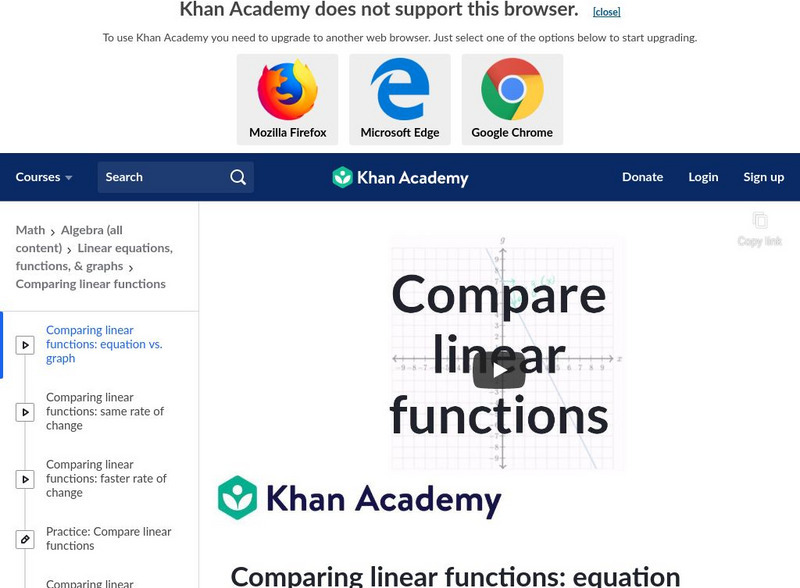Hi, what do you want to do?
Virtual Nerd
Virtual Nerd: How Do You Make a Table of Values for a Linear Equation?
To graph a linear equation, you first need to make a table of values to plot. This tutorial will teach you how to set up this table of values using an example. [5:41]
Khan Academy
Khan Academy: Application Problem With Graph
This video shows how to take a given equation in a word problem and create a table of (x,y) values that can be used to graph the equation. Once the table is graphed it demonstrates how to estimate a specific value on the graph in order...
Khan Academy
Khan Academy: Algebra: Graphs of Linear Equations
This video demonstrates how to graph a linear equation by creating a table of x, y values to use as coordinates for the graph of the line. The second example demonstrates how to take a word problem and create a table of values to graph...
Sophia Learning
Sophia: Comparing Linear, Quadratic, and Exponential Functions
Linear, quadratic and exponential functions have different graphs, equations, and characteristics. In this tutorial, compare the shape of linear, quadratic, and exponential curves on a graph, and explore how to identify a function as...
Sophia Learning
Sophia: Comparing Linear, Quadratic, and Exponential Functions
Linear, quadratic and exponential functions have different graphs, equations, and characteristics. In this tutorial, compare the shape of linear, quadratic, and exponential curves on a graph, and explore how to identify a function as...
Khan Academy
Khan Academy: Graphing Functions: Ex 1: Evaluating a Function
Video [5:07] evaluating a linear function written in function notation for two different values of x and an expression.
Khan Academy
Khan Academy: Graphing Functions: Ex 4: Graphing Radical Functions
Video [10:16] showing how to graph a radical function by specifically choosing values for x that result in easy-to-plot values of y and then plotting the points.
Khan Academy
Khan Academy: Introduction to Functions: Ex: Constructing a Function
This video demonstrates how to take a word problem and write a linear function that represents the problem.
Virtual Nerd
Virtual Nerd: How Can You Tell if Function Is Linear or Nonlinear From a Table?
Explains how to examine the values in a table to determine if the relationship between the variables is linear or nonlinear. [5:38]
Virtual Nerd
Virtual Nerd: How Do You Find the Rate of Change Between Two Points on a Graph?
Check out this tutorial to practice finding the rate of change using a graph. [4:51]
Virtual Nerd
Virtual Nerd: How Do You Find the Rate of Change Between Two Points in a Table?
This tutorial shows how to use the information given in a table to find the rate of change between the values in the table. [3:46]
Khan Academy
Khan Academy: Comparing Linear Functions: Table vs. Graph 1
Given a table of values for a linear function, see how to determine which of four linear graphs represents the same rate of change. [2:35]
Khan Academy
Khan Academy: Comparing Linear Functions: Table vs. Graph 2
Video lecture examines how to compare linear functions given a table of values and four linear graphs. How do you determine which graph increases faster than the function represented in the table? [3:39]
Khan Academy
Khan Academy: Linear and Nonlinear Functions: Table
In this video lesson, students will learn to determine if a table of values represents a linear function. [2:25]
Khan Academy
Khan Academy: Proportional Relationships With Graphs
Learn how to tell proportional relationships by drawing graphs.
Sophia Learning
Sophia: Finding Rates of Change in Linear Relationships
Explore how to find the rate of change in functions with linear relationships and take a quiz to assess learning.
Sophia Learning
Sophia: Graphs of Constant Rates of Change
Compare two lines to determine which one is a constant rate of change.
Sophia Learning
Sophia: Linear Equations From Tables of Data
This video tutorial demonstrates how to create a table of ordered pairs to test if a function is a linear equation. [4:43]
Sophia Learning
Sophia: Rates of Change on Graphs
Understand rate of change and how it is interpreted and represented on a graph. Assess learning with a quiz.
Sophia Learning
Sophia: Slope and Constant Rate of Change
Explore the relationship between slope and the constant rate of change for linear functions. Assess learning with a quiz. [3:42]
Sophia Learning
Sophia: Graphs of Constant Rates of Change
This video tutorial describes how to determine if a graph has a constant rate of change. It includes detailed examples.
Sophia Learning
Sophia: Graphing Linear Functions
Graph a linear function on a coordinate plane using the x- and y-intercepts. Assess learning with a quiz. [9:18]
Khan Academy
Khan Academy: Comparing Linear Functions: Equations vs. Graph
Compares the equation of one linear function with the graph of another to determine which of the given statements about them are true. [2:22]
Khan Academy
Khan Academy: Comparing Linear Functions Word Problem: Climb
This word problem is about two people who climb a wall. The formula is given for one and a table of values for the other and the problem asks who has the higher starting point, otherwise known as the initial value. [4:43]




























